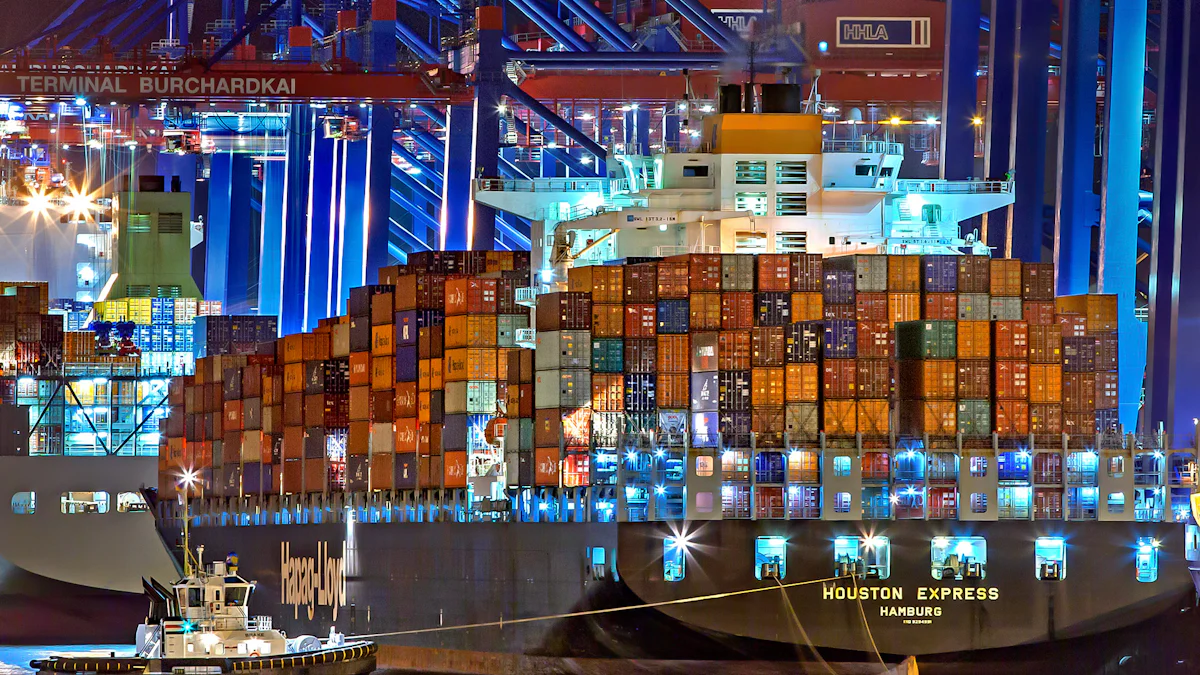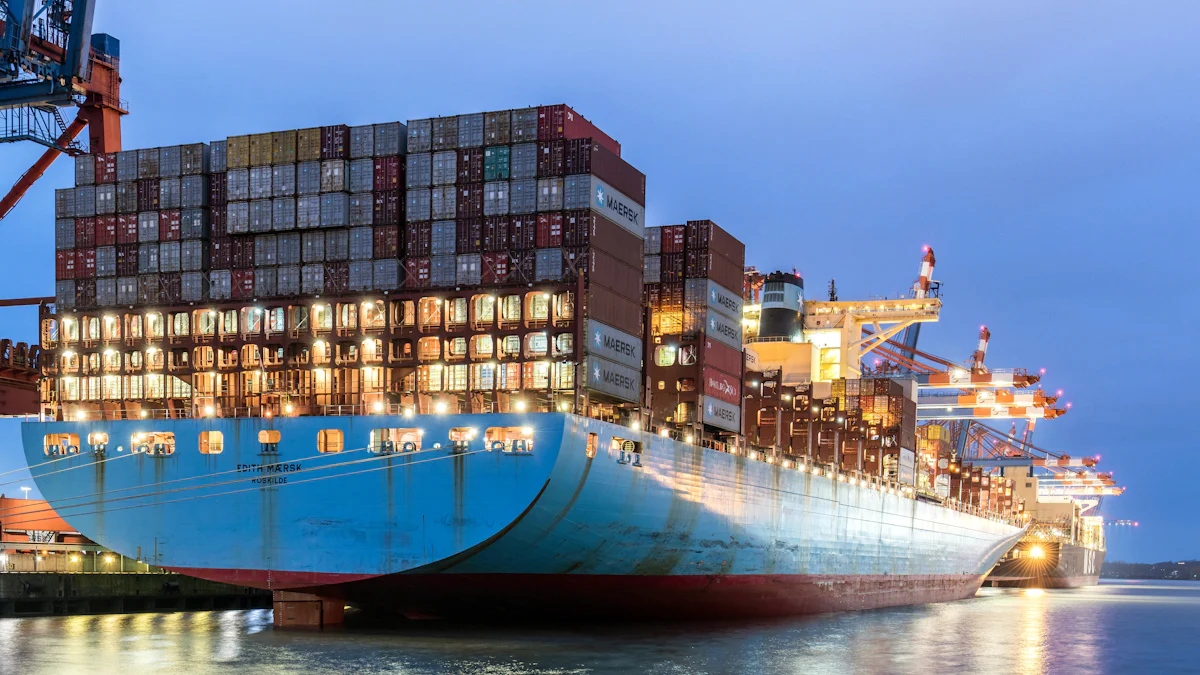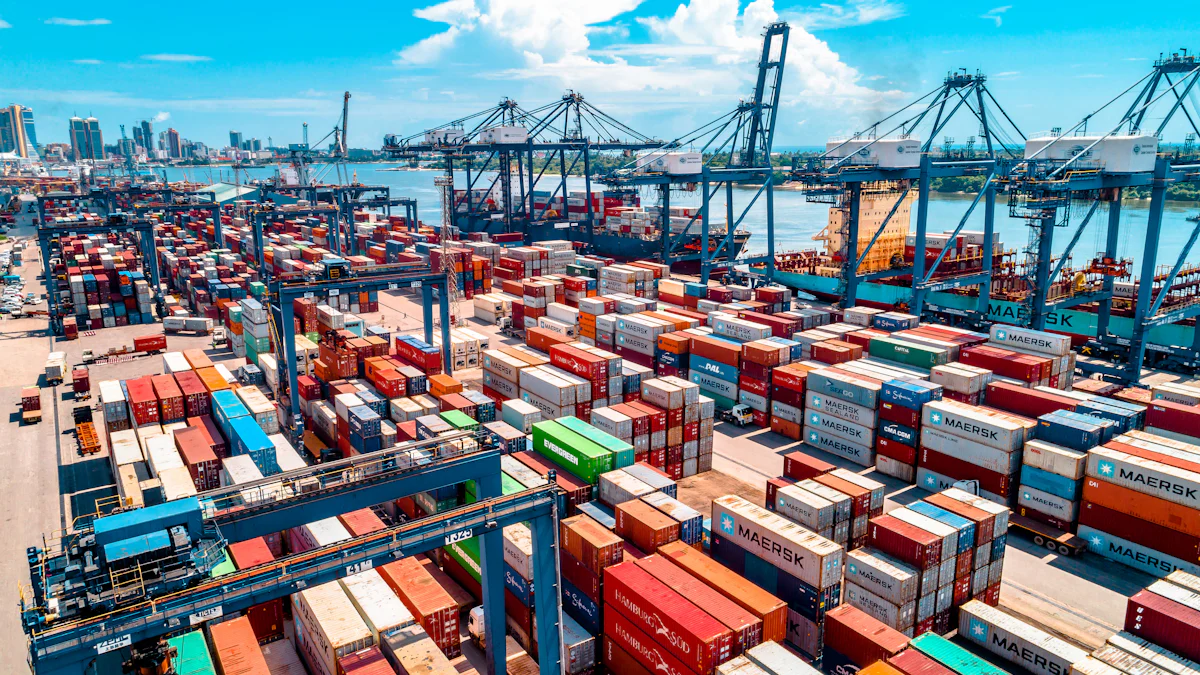Trends in Canadian Ocean Shipping Imports 2025

Ocean shipping plays a vital role in Canada’s trade ecosystem, ensuring the steady flow of goods across borders. In 2025, shifting supply-demand dynamics, evolving carrier strategies, and a projected 8% increase in shipping capacity will reshape import patterns. Labor strikes and e-commerce growth further influence shipping operations, creating challenges and opportunities for businesses.
Key Takeaways
Ocean shipping is very important for Canada's economy. It helps key industries and moves important goods.
By 2025, Canada expects ocean shipping to grow by 8%. This is because of more online shopping and higher consumer needs.
Big ports like Vancouver, Montreal, and Halifax are upgrading. They want to work faster and handle more trade.
Canada’s Economic Dependence on Ocean Shipping
Ocean shipping’s contribution to Canada’s trade ecosystem
Ocean shipping forms the backbone of Canada’s trade ecosystem. It supports the movement of goods across continents, ensuring businesses meet consumer demands. In 2025, the Ocean & Coastal Transportation industry in Canada is projected to reach a market size of $7.1 billion. This highlights its economic significance. You rely on ocean shipping for the import of essential goods, from electronics to raw materials. Without it, supply chains would face disruptions, affecting industries and consumers alike. The industry’s contribution extends beyond trade, creating jobs and driving economic growth in port cities.
Industries heavily reliant on ocean imports
Several Canadian industries depend heavily on ocean imports. The automotive sector relies on imported parts to maintain production schedules. Electronics manufacturers depend on components shipped from Asia. Retailers, especially those in e-commerce, depend on ocean shipping to stock their shelves with international products. The food industry also benefits, importing fruits, seafood, and other perishables. These industries rely on efficient shipping to keep costs low and operations smooth. You can see how delays or inefficiencies in ocean shipping could ripple through these sectors, impacting the economy.
Canada’s integration into global trade networks
Canada’s integration into global trade networks strengthens its ocean shipping operations. To compete globally, Canadian firms must operate at scale and maintain skilled personnel. Tight transportation links to international companies minimize costs and delays. Deep-water ports and intermodal transport services enhance logistics efficiency. Just-in-time supply chains increase container traffic, while cooperation among stakeholders ensures smooth operations. These factors make Canada a vital player in global trade, benefiting businesses like yours by improving shipping reliability and reducing costs.
Key Import Trends and Statistics for 2025
Major goods imported via ocean shipping
You might be surprised by the variety of goods Canada imports through ocean shipping. In 2025, industries like chicken egg production and automotive manufacturing dominate the import landscape. The table below highlights the top imported goods and their values:
Rank | Industry | Import Value (in billions) |
|---|---|---|
1 | Chicken Egg Production | |
2 | SUV & Light Truck Manufacturing | $66.1 |
3 | Aircraft, Engine & Parts Manufacturing | $25.8 |
4 | Oil Drilling & Gas Extraction | $23.9 |
5 | Petroleum Refining | $23.3 |
6 | Car & Automobile Manufacturing | $17.8 |
7 | Auto Parts Manufacturing | $17.4 |
8 | Iron & Steel Manufacturing | $15.8 |
9 | Brand-Name Pharmaceutical Manufacturing | $13.8 |
10 | Copper, Zinc & Lead Refining | $13.0 |
These goods reflect Canada’s reliance on ocean shipping to support key industries. For example, the automotive sector depends on imported vehicles and parts to meet consumer demand.
Top trade partners and their impact on Canadian imports
Canada’s trade partnerships shape its import trends. The United States remains the largest partner, accounting for nearly half of all imports. China, Mexico, Germany, and Japan also play significant roles. The table below provides a snapshot of these relationships:
Country | Value (in billion $) | Percentage of Total Imports | Description |
|---|---|---|---|
United States | 49% | Provides a wide range of goods, including machinery, vehicles, and fuels. | |
China | 63 | 10% | Major supplier of machinery, electronics, and textiles. |
Mexico | 36 | 6% | Supplies vehicles, machinery, and mineral fuels. |
Germany | 19 | 3% | Source of high-value goods like vehicles and pharmaceuticals. |
Japan | 15 | 2.5% | Exports vehicles, machinery, and medical instruments. |
These partnerships ensure a steady flow of goods, helping you access products from around the world.
Volume trends and year-over-year changes in ocean shipping
In 2025, ocean shipping volumes are expected to grow steadily. Analysts predict a year-over-year increase of 8%, driven by rising consumer demand and expanding e-commerce. This growth reflects the resilience of global trade networks. You can expect Canadian ports to handle higher container traffic, with Vancouver, Montreal, and Halifax playing critical roles. These trends highlight the importance of efficient logistics to meet growing import demands.
Strategic Shipping Routes and Ports in Canada

The importance of Vancouver, Montreal, and Halifax ports
Canada’s ports play a vital role in supporting international trade. Each port has unique strengths that contribute to the country’s ocean shipping operations.
Port | Strategic Role |
|---|---|
Vancouver | Primary gateway for trade with over 170 countries, crucial for non-North American trade flows. |
The Port of Montreal is the second busiest in Canada, holding 3.7% of the North American market share. It connects to over a hundred countries across five continents, making it a key hub for global trade.
The Port of Halifax is known as North America’s first inbound and last outbound point, reaching Europe two days faster and Asia one day faster than other East Coast ports.
These ports ensure efficient trade routes, helping you access goods from around the world.
Recent developments in Canadian port infrastructure
Canadian ports are undergoing significant upgrades to meet growing trade demands. On the East Coast, ports are expanding capacity and adopting sustainable practices.
The Port of Halifax is extending Ocean Terminals to increase yard space for container operations. It is also exploring sustainable cruise ship expansion.
The Port Saint John completed the West Side Modernization project, boosting container traffic from over 100,000 TEUs in 2022 to 153,000 TEUs in 2023.
The port is adding post-Panamax cranes to enhance its container terminal capacity.
The Port of Sept-Îles is investing C$30 million to refurbish the Monseigneur-Blanche terminal, accommodating larger bulk carriers.
These developments improve efficiency and sustainability, ensuring smoother logistics for your business.
Key global shipping routes connected to Canada
Canada’s trade relies on strategic global shipping routes. The Pacific Gateway, through Vancouver and Prince Rupert, connects you to Asian markets. The Atlantic Gateway, centered around Halifax and Montreal, links Canada to Europe and the Suez Canal.
Both gateways handle the increasing size of global shipping vessels and meet the demands of international trade. These routes ensure Canada remains a critical player in global commerce, helping you benefit from reliable and efficient trade connections.
The Role of Technology in Ocean Shipping
Automation and AI in shipping logistics
Automation and artificial intelligence (AI) are transforming how you experience shipping logistics. Ports now use robotic offloading technologies to unload cargo faster and reduce labor costs. Automated cargo ships are also being developed. These ships simplify logistics by allowing remote monitoring and improving safety. The Internet of Things (IoT) plays a key role in monitoring conditions inside shipping containers. This ensures goods remain safe and shipping processes become more efficient. These advancements make ocean shipping more reliable and cost-effective for your business.
Digitalization of supply chains for enhanced efficiency
Digitalization is reshaping supply chains, making them more efficient and transparent. Advanced platforms now allow you to track shipments in real time. This helps you plan better and avoid delays. Cloud-based systems connect different parts of the supply chain, from procurement to delivery. These systems improve communication and reduce errors. Big data analytics also provide insights into shipping trends, helping you make informed decisions. By adopting digital tools, you can optimize your supply chain and stay competitive in a fast-changing market.
JusTrade’s role in streamlining customs clearance for ocean imports
JusTrade simplifies customs clearance, ensuring your ocean imports arrive on time. Its intelligent SAAS platform integrates AI and big data to handle complex customs processes. This platform connects with your ERP system, creating a seamless flow of information. It categorizes commodities, tracks shipments, and ensures compliance with regulations. JusTrade also offers real-time updates, so you always know the status of your imports. With its efficient solutions, JusTrade helps you save time and reduce costs, making your logistics operations smoother.
Sustainability in Canadian Ocean Shipping

Canada’s initiatives to reduce shipping emissions
Canada has taken significant steps to reduce emissions in ocean shipping. These initiatives reflect the country’s commitment to sustainability and its role in global environmental efforts.
A majority of Canadians (64%) support paying more for imported goods to offset shipping emissions. This public backing strengthens the push for greener practices.
Canada has pledged to achieve zero emissions in ocean shipping by 2050. This includes setting decarbonization goals through the International Maritime Organization (IMO).
Initiative | Description |
|---|---|
Zero Emission Shipping by 2050 | Canada collaborates with other governments to eliminate shipping emissions. |
These efforts aim to create a cleaner and more sustainable shipping industry for future generations.
Adoption of green technologies in shipping fleets
Green technologies are transforming Canadian shipping fleets. The government has prioritized electrification and shore power technology to reduce emissions. These advancements align with Canada’s strategy to decarbonize the marine sector.
Major ports like Vancouver and Prince Rupert now offer shore power infrastructure. Ships can connect to the electrical grid, reducing reliance on onboard generators.
The Green Marine program encourages continuous improvement in environmental performance.
Investments in clean ships accelerate the adoption of next-generation vessels.
These technologies not only lower emissions but also enhance the efficiency of shipping operations.
International regulations shaping sustainable ocean shipping
International regulations play a crucial role in shaping sustainable practices. Canada has adopted ambitious goals to achieve zero greenhouse gas emissions from international shipping by 2050.
Decarbonization targets for 2030 and 2040 guide the industry toward full sustainability.
Measures to meet these goals will begin implementation by 2025.
Canada’s shipping laws, including the Canada Shipping Act and the Marine Liability Act, ensure compliance with international conventions like MARPOL and SOLAS. These regulations create a framework for sustainable practices, helping you navigate the complexities of global trade.
JUSDA’s Contribution to Canadian Ocean Shipping
JUSDA’s ocean shipping solutions for diverse industries
JUSDA provides tailored ocean shipping solutions to meet the unique needs of various industries. You can rely on JUSDA’s expertise whether you operate in electronics manufacturing, automotive, or fast-moving consumer goods. The company’s global network, with over 155 service points, ensures seamless transportation of goods across continents. JUSDA’s services include end-to-end logistics, consolidation, and cloud warehousing. These solutions help you optimize costs and improve delivery timelines. By leveraging advanced technologies like IoT and big data, JUSDA enhances visibility and efficiency in your supply chain. This makes it easier for you to manage complex logistics and meet customer expectations.
How JusTrade simplifies customs clearance for Canadian imports
JusTrade transforms customs clearance into a hassle-free process. Its intelligent SAAS platform integrates with your ERP system, streamlining every step of the customs process. You can track shipments in real time, categorize commodities, and ensure compliance with regulations. JusTrade’s AI-powered tools reduce errors and speed up clearance times. This allows you to avoid delays and maintain production schedules. With operations in nearly 20 countries, JusTrade offers global coverage for your import needs. Its innovative approach ensures your goods move smoothly through customs, saving you time and money.
Leveraging JUSDA’s supply chain expertise for efficient logistics
JUSDA’s supply chain expertise helps you navigate the complexities of global trade. The company’s collaboration platform integrates demand forecasting, transport coordination, and inventory management. This ensures you can plan effectively and reduce risks. JUSDA’s solutions also include real-time tracking, which keeps you informed about your shipments. By using JUSDA’s services, you can optimize your logistics operations and achieve greater efficiency. The company’s commitment to innovation and customer satisfaction makes it a trusted partner for businesses like yours.

JUSDA Solutions
To provide you with professional solutions and quotations.
The trends in Canadian ocean shipping imports for 2025 highlight growth in e-commerce, sustainability efforts, and technological advancements. These changes impact your business operations and logistics planning. Policymakers must prioritize investments in Atlantic coast ports like Halifax and Montreal to address West Coast congestion. A unified strategy linking Pacific, Atlantic, and St. Lawrence-Great Lakes corridors strengthens Canada’s trade position.
See Also
Discovering 2024 Innovations in Sea Freight Logistics
Five Key Trends Shaping Future Supply Chain Efficiency
Understanding Current Trends in Logistics Risk Management
Get Prepared: New Transport Tech Innovations for Supply Chains
